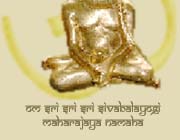Shivabalayogi Devotee Satsang
 Experiences
and Insights
Experiences
and Insights
|
|
A Yogi's Anger A yogi shows anger, but does not lose temper or get upset. D. Jagadish Kumar shares some personal experiences of Shivabalayogi.
|
|
|
What Yogis Know While yogis have the ability to meditate to know anything, they do that only when necessary.
|
|
Bhava Samadhi Yogis present in bhava samadhi are able to do whatever they could do in their own physical bodies. But, there is a limitation. Insights on bhava samadhi shared by D. Jagadish Kumar.
|
|
Swamiji on the Dais When Shivabalayogi is sitting on a dais and giving public darshan, he offers himself equally to all devotees. When Swamiji is in a more informal setting, he acts like any other person, even joining in the work of the ashram.
|
|
Tapas Tapas means meditation in samadhi (the state of enlightenment) until god appears and grants the boon the tapaswin (one who sits in tapas) desires. Those who complete tapas without any personal desire become an Agent of God.
|
|
Seven Balayogis There were seven balayogis (those who sit in tapas, meditation in samadhi, while still a child) who sat in tapas around the same time in the East Godavari District of India. One was Shivabalayogi (Adivarapupeta Balayogi) who mastered tapas in all four cardinal directions in eight years. Another was the elder Mummidivaram Balayogi who mastered tapas to the east in twelve years. The bodies of other five tapaswins (those who sit in tapas), as best we know, perished while in tapas. |
|
Guru To see God, one needs the help of a Guru. Just like Arjuna, to see the Vishwarupa (the Universal Form of Krishna), much less the full form of Krishna as God, needed Krishna's help.
|
|
Spiritual Powers One who successfully completes tapas acquires powers (tapas shakti). A true yogi never uses such powers for selfish purposes. For example, although Shivabalayogi used his powers to heal people of all kinds of afflictions, he never used them to heal his own physical ailments.
|
|
Ramakrishna Jagadish shares a story that Swamiji told about being stuck overnight in Calcutta. Swamiji used the time to visit Dakshineswar where Ramakrisha lived and did puja to the Divine Mother. The taxi driver who took Swamiji and the temple priest who let Swamiji inside both recognized Swamiji as the reincarnation of Ramakrishna.
|
|
Mataji Swamiji considered Mataji - Maharani Kailash Kumari Devi - to be his second mother. Jagadish shares the story of how Mataji came to Swamiji.
|
|
Sri Harikotishwara Linga Sri Harikotishwara is an ancient lingam found by the sea at Sri Harikota, on the southeast coast of India. Swamiji said it had been worshiped by Arjuna. Jagadish shares the story of how it was recovered and how Swamiji re-consecrated it.
|
|
Disposing of Ganesha At the end of the annual festival in honor of Ganesha, Ganesh Chaturthi, the clay idol of Ganesha is disposed into waters. Shivabalayogi's own practices gives a practical explanation for the tradition.
|



